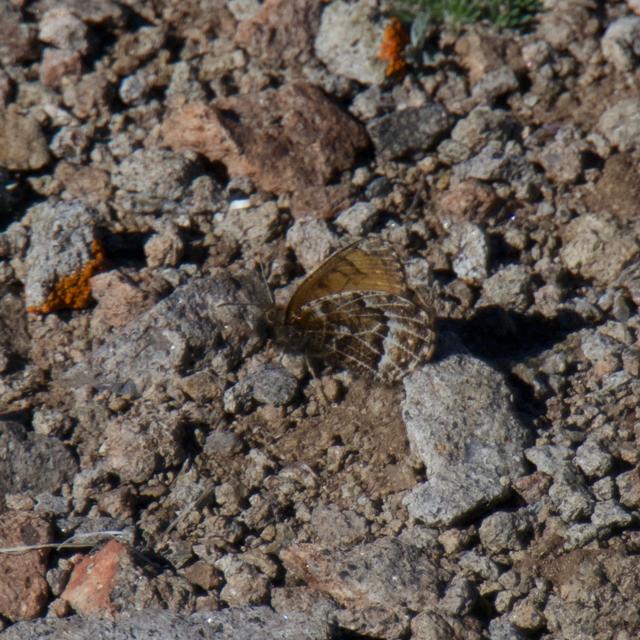National Moth Week is July 20-28, 2024!
Moths are amazing creatures. Take photographs and share your moth sightings with us to document the moths where you live.
White-veined Arctic
Oeneis bore (Esper, 1798)
Family: Nymphalidae
Subfamily: Satyrinae
Identification: Wings are translucent, veins are usually white. Upperside is gray-brown with no eyespots. Underside is light brown; hindwing has a dark median band outlined in white.
Wing Span: 1 7/16 - 1 7/8 inches (3.7 - 4.8 cm).
Life History: To find females, males perch and patrol all day on grassy hillsides or swales. Females lay eggs on dead grass or sedge blades. Two years are required to complete development; the first winter is passed by first-stage caterpillars, the second winter by mature caterpillars.
Flight: One brood in late July.
Caterpillar Hosts: Grasses or sedges.
Adult Food: Occasionally flower nectar.
Habitat: Tundra, grassy alpine slopes, and subarctic bogs.
Range: Holarctic. In North America, high arctic tundra from Alaska east to Labrador. Isolated populations in the alpine Rocky Mountains south to southwest Colorado. Isolated population on Mt. Albert, Quebec.
Conservation: Not usually required.
NCGR: G5 - Demonstrably secure globally, though it may be quite rare in parts of its range, especially at the periphery.
Management Needs: None reported.
Get your BAMONA Gear!
Please donate!
We depend on donations to keep Butterflies and Moths of North America freely available. We want to express our gratitude to all who showed their support by making a contribution this year. You can donate to support this project at any time.
Advertise with us!
Do you have a product or service that you think would interest BAMONA users? If you would like to advertise on this website, contact us by email, or use the contact form and select the "Advertising" category.
Verified Sightings
Displaying 1 - 24 of 61 verified sightings

Observation date: Jun 22, 2024
Submitted by: John Gibbons
Region: Newfoundland and Labrador, Canada
Verified by: jwileyrains
Verified date: Jun 23, 2024

Observation date: Jun 22, 2022
Submitted by: Rick Sinnott
Region: Denali, Alaska, United States
Verified by: davidwdroppers
Verified date: Aug 21, 2023

Observation date: Jul 22, 2023
Submitted by: NikkiM
Region: Park County, Wyoming, United States
Verified by: J_Martineau
Verified date: Aug 10, 2023

Observation date: Jul 22, 2023
Submitted by: NikkiM
Region: Park County, Wyoming, United States
Verified by: J_Martineau
Verified date: Aug 10, 2023

Observation date: Jul 15, 2023
Submitted by: NikkiM
Region: Carbon County, Montana, United States
Verified by: J_Martineau
Verified date: Jul 25, 2023

Observation date: Jun 16, 2021
Submitted by: dannynelson94
Region: Bethel, Alaska, United States
Verified by: Paul Prappas
Verified date: Feb 11, 2023

Observation date: Jun 23, 2019
Submitted by: jsaunders260
Region: Matanuska-Susitna, Alaska, United States
Verified by: Paul Prappas
Verified date: Feb 10, 2023

Observation date: Jun 29, 2019
Submitted by: jsaunders260
Region: Valdez-Cordova, Alaska, United States
Verified by: Paul Prappas
Verified date: Feb 10, 2023

Observation date: Jun 29, 2019
Submitted by: jsaunders260
Region: Valdez-Cordova, Alaska, United States
Verified by: Paul Prappas
Verified date: Feb 09, 2023

Observation date: Jul 18, 2020
Submitted by: jsaunders260
Region: Matanuska-Susitna, Alaska, United States
Verified by: Paul Prappas
Verified date: Feb 09, 2023

Observation date: Jul 18, 2020
Submitted by: jsaunders260
Region: Matanuska-Susitna, Alaska, United States
Verified by: Paul Prappas
Verified date: Feb 07, 2023

Observation date: Jun 23, 2021
Submitted by: Rick Sinnott
Region: Denali, Alaska, United States
Verified by: Paul Prappas
Verified date: Feb 07, 2023

Observation date: Jun 27, 2019
Submitted by: Rick Sinnott
Region: Anchorage, Alaska, United States
Verified by: Paul Prappas
Verified date: Feb 07, 2023

Observation date: Jun 07, 2019
Submitted by: tylerjkrul
Region: Denali, Alaska, United States
Verified by: Paul Prappas
Verified date: Feb 07, 2023

Observation date: Jun 02, 2019
Submitted by: RobertWeeden
Region: North Slope, Alaska, United States
Verified by: Paul Prappas
Verified date: Feb 07, 2023

Observation date: Jul 29, 2011
Submitted by: NikkiM
Region: Carbon County, Montana, United States
Verified by: J_Martineau
Verified date: Mar 18, 2021

Observation date: Jul 18, 2020
Submitted by: jsaunders260
Region: Matanuska-Susitna, Alaska, United States
Verified by: davidwdroppers
Verified date: Dec 17, 2020

Observation date: Jul 22, 2019
Submitted by: Christian.Nunes
Region: Colorado, United States
Verified by: mikefisher
Verified date: Oct 05, 2019

Observation date: Jul 10, 2019
Submitted by: pnesterenko
Region: Colorado, United States
Verified by: mikefisher
Verified date: Sep 23, 2019

Observation date: Jun 22, 2018
Submitted by: JKlodzen
Region: North Slope, Alaska, United States
Verified by: Norbert Kondla
Verified date: Nov 24, 2018

Observation date: Jun 23, 2018
Submitted by: Doug Bruce
Region: Nome, Alaska, United States
Verified by: Norbert Kondla
Verified date: Nov 24, 2018

Observation date: Jul 09, 2006
Submitted by: hydapse
Region: Carbon County, Montana, United States
Verified by: J_Martineau
Verified date: Aug 03, 2018

Observation date: Jul 02, 2016
Submitted by: janazak
Region: Yukon Territory, Canada
Verified by: davidwdroppers
Verified date: Jul 19, 2016

Observation date: Jun 28, 2016
Submitted by: janazak
Region: Yukon Territory, Canada
Verified by: davidwdroppers
Verified date: Jul 12, 2016
- 1 of 3
- next ›



